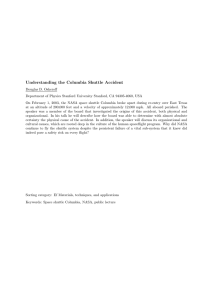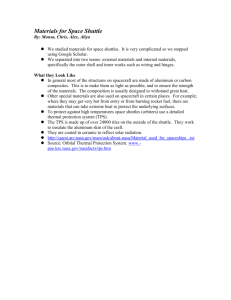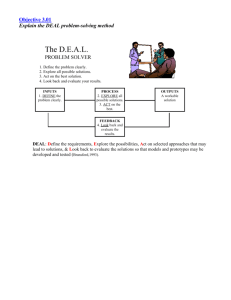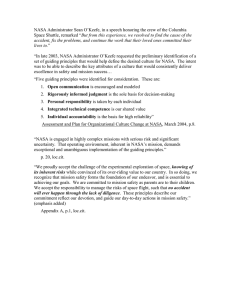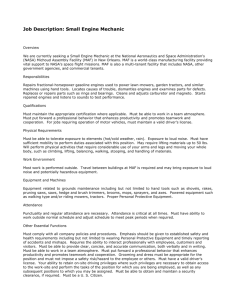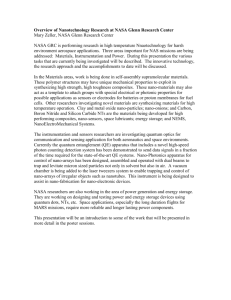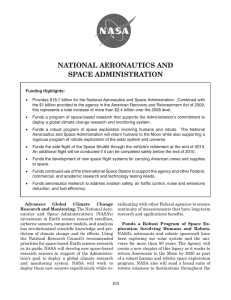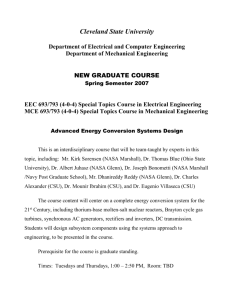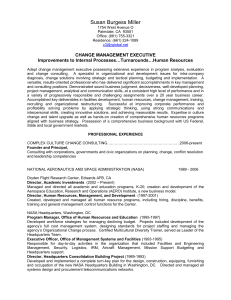Supporting Data:
advertisement
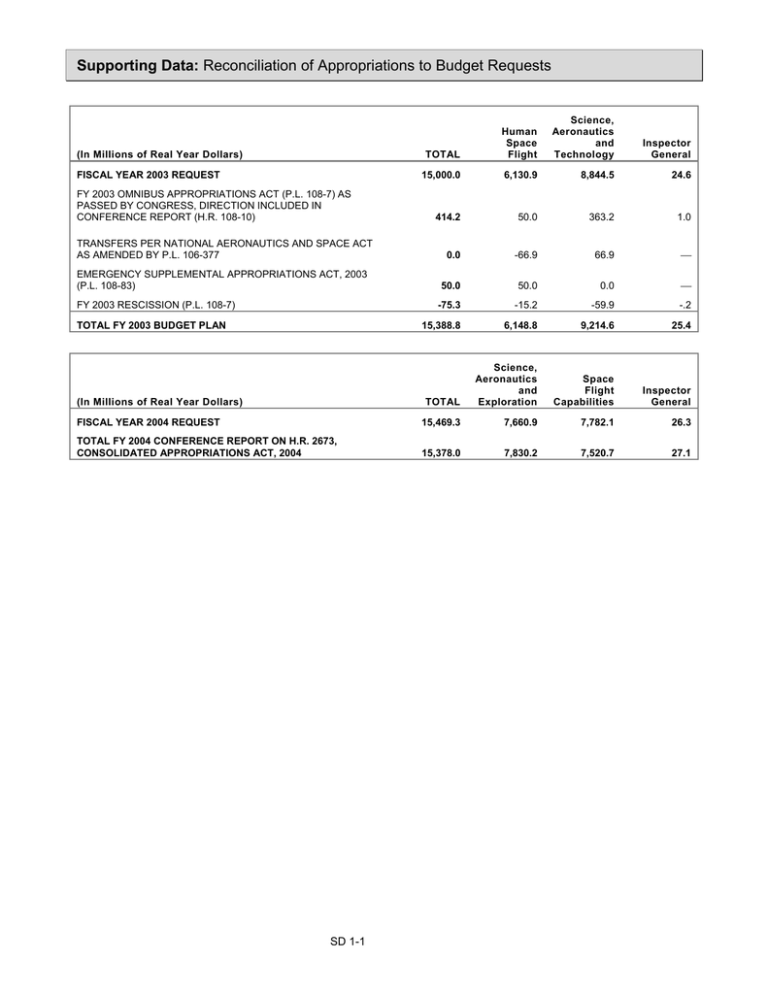
Supporting Data: Reconciliation of Appropriations to Budget Requests TOTAL Human Space Flight Science, Aeronautics and Technology Inspector General 15,000.0 6,130.9 8,844.5 24.6 414.2 50.0 363.2 1.0 TRANSFERS PER NATIONAL AERONAUTICS AND SPACE ACT AS AMENDED BY P.L. 106-377 0.0 -66.9 66.9 ⎯ EMERGENCY SUPPLEMENTAL APPROPRIATIONS ACT, 2003 (P.L. 108-83) 50.0 50.0 0.0 ⎯ -75.3 -15.2 -59.9 -.2 15,388.8 6,148.8 9,214.6 25.4 TOTAL Science, Aeronautics and Exploration Space Flight Capabilities Inspector General FISCAL YEAR 2004 REQUEST 15,469.3 7,660.9 7,782.1 26.3 TOTAL FY 2004 CONFERENCE REPORT ON H.R. 2673, CONSOLIDATED APPROPRIATIONS ACT, 2004 15,378.0 7,830.2 7,520.7 27.1 (In Millions of Real Year Dollars) FISCAL YEAR 2003 REQUEST FY 2003 OMNIBUS APPROPRIATIONS ACT (P.L. 108-7) AS PASSED BY CONGRESS, DIRECTION INCLUDED IN CONFERENCE REPORT (H.R. 108-10) FY 2003 RESCISSION (P.L. 108-7) TOTAL FY 2003 BUDGET PLAN (In Millions of Real Year Dollars) SD 1-1 Supporting Data: FY 2003 Appropriation by Budget Line Item FY 2003 APPROPRIATION STRUCTURE Request 9/04/2003 Operating Plan HUMAN SPACE FLIGHT 6,130.9 6,148.8 INTERNATIONAL SPACE STATION 1,492.1 1,462.4 SPACE SHUTTLE 3,208.0 3,301.4 PAYLOAD & ELV SUPPORT 87.5 84.4 1,178.2 1,136.5 117.5 115.3 47.6 48.8 SCIENCE, AERONAUTICS & TECHNOLOGY 8,844.5 9,214.6 SPACE SCIENCE 3,414.3 3,530.6 842.3 882.6 EARTH SCIENCE 1,628.4 1,716.8 AEROSPACE TECHNOLOGY 2,815.8 2,886.0 ACADEMIC PROGRAMS 143.7 198.6 INSPECTOR GENERAL 24.6 25.4 15,000.0 15,388.8 HEDS INVESTMENTS AND SUPPORT SPACE COMMUNICATION & DATA SYSTEMS SAFETY, MISSION ASSURANCE & ENGINEERING BIOLOGICAL & PHYSICAL RESEARCH TOTAL AGENCY Note: Shuttle funding includes $50M Supplemental SD 1-2 Supporting Data: Reimbursable Estimates R E I M B U R S AB LE ES TI M AT E S B Y A P P R O P R I AT I O N Budget Authority ($ in millions) FY 2003 Human Space Flight 251.0 Science, Aeronautics and Technology 526.0 FY 2004 Science, Aeronautics and Exploration 677.0 Space Flight Capabilities 357.0 FY 2005 Exploration, Science and Aeronautics 664 Exploration Capabilities 351 Total 777.0 SD 1-3 1,034 1,015 Supporting Data: Funds by Installation D I S T R I B U TI O N O F F U N D S B Y I N S T AL L ATI O N (In millions of dollars) Ames Research Center Glenn Research Center Direct Personnel Dryden Flight Research Center Goddard Space Flight Center FY 2005 103 116 Direct Travel 4 4 Center G& A 129 124 Service Pools 172 74 Program CoF 0 0 Total 408 318 FTEs 1,444 1,409 159 154 3 3 Center G& A 99 106 Service Pools 84 89 Program CoF 7 0 Total 352 352 FTEs 1,934 1,934 141 133 Direct Travel 3 3 Center G& A 142 120 Service Pools 126 112 Program CoF 0 0 Total 412 368 FTEs 2,365 2,365 35 38 Direct Travel 1 1 Center G& A 40 53 Service Pools 37 23 Program CoF 0 0 Total 113 115 FTEs 566 567 Direct Personnel Direct Personnel Direct Travel Langley Research Center FY 2004 Direct Personnel Direct Personnel 218 229 Direct Travel 6 5 Center G& A 170 183 Service Pools 146 131 Program CoF 0 0 Total 540 548 FTEs 3,329 3,334 SD 1-4 Supporting Data: Funds by Installation Marshall Flight Center Stennis Space Center Johnson Space Center Kennedy Space Center Jet Propulsion Laboratory Direct Personnel 205 181 Direct Travel 5 4 Center G& A 145 143 Service Pools 119 89 Program CoF 8 18 Total 482 435 FTEs 2,684 2,597 Direct Personnel 16 17 Direct Travel <1 <1 Center G& A 39 44 Service Pools 17 21 Program CoF 2 3 Total 74 85 FTE’s 300 295 Direct Personnel 258 284 Direct Travel 7 8 Center G& A 158 185 Service Pools 121 124 Program CoF 4 1 Total 548 602 FTEs 2,895 2,850 114 129 Direct Travel 3 3 Center G&A 168 243 Service Pools 112 77 Program CoF 43 33 Total 440 485 FTEs 1,798 1,748 Direct Personnel N/A since FFRDC FY 2004 and FY 2005 FTEs are under review as NASA begins implementing the President’s new vision for space exploration. SD 1-5 Supporting Data: Civil Service Distribution CIVIL SERV ICE DIS TRIBUTION OF FULL TIME EQUIV ALE NTS The civil service workforce is the underpinning for the successful accomplishment of the Nation’s civil aeronautics and space programs. These are the people who plan the programs; conduct and oversee the research; select and monitor the contractors; manage the various research, development, and test activities; and oversee all of NASA’s operations. A key dimension of the reinvention of NASA has been the restructuring of the civil service workforce to deliver a space and aeronautics program that is balanced, relevant, and at the forefront of technology development. The FY 2004 and FY 2005 FTE values provides for a human capital initiative targeting fresh-out and at risk technical talents that are needed. These numbers are presently under review. NASA’s primary goals for its civil service workforce are to: Acquire and maintain a civil service workforce reflecting the cultural diversity of the Nation; and Provide a workforce sized and skilled as need to accomplishing NASA’s research, development, and operational missions with innovation, excellence, and efficiency. C I V I L S E R V I C E D I S TR I B U TI O N D E T AI L Full Time Equivalents (FTEs) FY 2003 FY 2004 FY 2005 Johnson Space Center 2,970 2,895 2,850 Kennedy Space Center 1,835 1,798 1,748 Marshall Space Flight Center 2,690 2,684 2,597 Stennis Space Center 296 300 295 1,445 1,444 1,409 578 566 567 Langley Research Center 2,352 2,365 2,365 Glenn Research Center 1,898 1,934 1,934 Goddard Space Flight Center 3,301 3,329 3,334 Headquarters 1,153 1,378 1,392 ⎯ 150 250 18,518 18,843 18,741 Ames Research Center Dryden Flight Research Center Human Capital Initiative Total FY 2004 and FY 2005 FTEs are under review as NASA begins implementing the President’s new vision for space exploration. SD 1-6 Supporting Data: Consulting Services S U M M AR Y O F C O N S U L T I N G S E R V I C E S NASA uses paid experts and consultants to provide NASA with advice and expert input in addition to or beyond that available from its in-house civil service workforce. NASA established management controls assure that there is ample justification presented and the action is approved at top management levels before entering into a consulting services arrangement with an individual. NASA also uses experts and consultants to provide expert advice and input on the selection of experiments for future space missions. The use of these experts and consultants, in addition to NASA civil service personnel, provides the Agency with an independent view that assures the selection of experiments likely to have the greatest scientific merit. Other individuals are used to provide independent analysis of technical and functional problems in order to give top management the widest possible range of views before making major decisions. Expert/Consultants (Total NASA) FY 2003 FY 2004 FY 2005 41 50 50 4 4 4 Salaries $441,000 $449,820 $458,816 Total Salary and Benefits Costs $474,737 $484,231 $493,916 Travel Costs $540,513 $556,728 $573,430 Total Costs $1,015,250 $1,040,959 $1,067,346 Number of Paid Experts and Consultants Annual FTE Usage SD 1-7 Supporting Data: Construction of Facilities S U M M AR Y O F R E S O U R C E S I N C L U D E D I N B U D G E T R E Q U E S T In Millions of Dollars Exploration, Science and Aeronautics Programs* Exploration Capabilities Programs* FY 2003 FY 2004 FY 2005 27.0 7.0 -- 58.9 57.3 55.2 Non-Programmatic Programs (included within G&A) 165.1 184.0 152.5 Total Construction of Facilities 251.0 248.3 207.7 * FY 2003 and FY 2004 data shown mapped to new FY 2005 appropriation accounts. The Construction of Facilities (CoF) program ensures that the facilities critical to achieving NASA’s space and aeronautics programs are available, safe, secure, environmentally sound, operate efficiently and effectively, and that NASA installations conform to requirements and initiatives for the protection of the environment and human health. NASA facilities are essential to the Agency and facility revitalization is needed to maintain infrastructure that is safe and capable of supporting NASA’s missions. The facilities being revitalized or constructed in this program are expected to remain active in the long term and are consistent with current and anticipated Agency roles and missions, although some adjustments may be required to reflect the new vision for space exploration announced in January 2004. NASA is also conducting a Real Property Mission Analysis (RPMA), which should be complete in FY 2005. The RPMA is an independent, top-down, mission-driven process to identify the physical plant necessary to support NASA’s Mission and programs, identify shortages and excesses, and make recommendations regarding the disposition of excesses to ensure that NASA owns and maintains only essential real property. Funding for construction projects required for specific programs is included in the appropriate budget line item within each Enterprise. Non-Programmatic CoF projects are required for components of NASA’s basic infrastructure and institutional facilities. Beginning in FY 2004, funding for Non-Programmatic CoF identified to specific Centers has been included in that Center’s General and Administrative (G&A) rate, and agency-wide initiatives are included as part of Corporate G&A. Descriptions and cost estimates of both non-programmatic and programmatic (or “program direct”) projects are provided to show a complete picture of NASA’s budget requirement for facilities revitalization and construction. The institutional facility projects requested for FY 2005 continue the vital rehabilitation, modification, and repair of facilities to renew and help preserve and enhance the capabilities and usefulness of existing facilities and ensure the safe, economical, and efficient use of the NASA physical plant. They repair and modernize deteriorating and obsolete building and utility systems that have reached or exceeded their normal design life, are no longer operating effectively or efficiently, and cannot be economically maintained. These systems include mechanical, structural, cooling, steam, electrical distribution, sewer, and storm drainage. Some projects replace substandard facilities in cases where it is more economical to demolish and rebuild than it is to restore. Projects between $0.5 million and $5.0 million are included as Minor Revitalization and Construction projects, and projects with an estimated cost of at least $5.0 million are budgeted as discrete projects. (Projects less than $0.5 million are accomplished by routine day-to-day facility maintenance and repair activities provided for in direct program and Center operating budgets.) Should residual resources become available from any Minor Revitalization or Discrete projects, they will be used for urgently needed facility revitalization requirements and Congress will be notified before work is initiated for any such discrete projects. Funds requested for Facility Planning and Design (FP&D) cover: advance planning and design requirements for future projects; preparation of facility project design drawings and bid specifications; master planning; facilities studies; engineering reports and studies; and critical functional leadership activities directed at increasing the rate of return of constrained Agency resources while keeping the facility infrastructure safe, reliable, and available. SD 1-8 Supporting Data: Construction of Facilities S U M M AR Y O F F Y 2 0 0 5 P R O G R AM D I R E C T P R O J E C T S B Y P R O G R AM In Millions of Dollars FY 2003 FY 2004 FY 2005 27.0 7.0 0.0 SPACE SCIENCE 8.6 0.0 0.0 Construct 34-Meter Beam Waveguide Antenna, Madrid, Spain (JPL) 2.0 ⎯ ⎯ Facility Planning and Design 6.6 ⎯ ⎯ BIOLOGICAL AND PHYSICAL RESEARCH 2.8 0.0 0.0 Construct Booster Applications Facility, Brookhaven National Laboratory 2.8 ⎯ ⎯ 15.6 7.0 0.0 Modify Cell W-2 for Dual-Spool Turbine Research, ERB (GRC) 4.9 7.0 ⎯ Upgrade E-Complex Test Capabilities 4.0 ⎯ ⎯ Upgrade to Propulsion Test Complex 4.0 ⎯ ⎯ Development of Stennis Visitor's Center 2.7 ⎯ ⎯ 58.9 57.3 55.2 56.5 53.9 54.0 Repairs to Vehicle Assembly Building (VAB) (KSC) ⎯ ⎯ 23.7 Repairs to Launch Complex LC-39A (KSC) ⎯ 22.4 ⎯ Replace Roof, Vehicle Assembly Building (KSC) ⎯ 16.0 ⎯ Replace 15kV Feeders, Shuttle Landing Facility Area (KSC) 1.7 ⎯ ⎯ Replace 15kV Feeders, East Area VAB (KSC) 2.2 ⎯ ⎯ Replace Hi-Pressure Nitrogen & Helium Pipelines, LC39 Area (KSC) 4.8 ⎯ ⎯ Restore Low Voltage Power System, LC-39A (KSC) 2.0 ⎯ ⎯ Restore Low Voltage Power System, LC-39B (KSC) 1.7 ⎯ ⎯ Restore Low Voltage Power System, MLP, Phase 1 (KSC) 2.5 ⎯ ⎯ Integrate Chilled Water System (110/114/130/131) (MAF) 1.7 ⎯ ⎯ Rehabilitate and Modify Crane Control System 110/114 (MAF) 1.6 ⎯ ⎯ Repair Downspouts, ET Manufacturing Building (MAF) 2.7 ⎯ ⎯ Replace Cell "E" Air Handling Units, Building 110 (MAF) 1.7 ⎯ ⎯ Replace Chilled Water Laterals 103 (MAF) 2.2 ⎯ ⎯ Replace Chilled Water, Steam, and Condensate Systems 110/114 (MAF) 1.9 ⎯ ⎯ Replace Paint Spray Facility, Building 103 (MAF) 1.6 ⎯ ⎯ Repair and Modernize Space Shuttle Main Engine A-2 Test Stand (SSC) 1.9 ⎯ ⎯ EXPLORATION, SCIENCE & AERONAUTICS COF PROGRAMS AERONAUTICS* EXPLORATION CAPABILITIES COF PROGRAMS SPACE SHUTTLE Minor Revitalization of Facilities at Various Locations (less than $5M per project) 21.4 13.8 26.0 Facility Planning and Design 4.9 1.7 4.3 SPACE AND FLIGHT SUPPORT 2.4 3.4 1.2 Minor Revitalization of Facilities at Various Locations (less than $5M per project) 2.4 3.0 0.9 ⎯ 0.4 0.3 Facility Planning and Design * FY03 includes the non-aeronautics portion of Aerospace Technology SD 1-9 Supporting Data: Construction of Facilities S U M M AR Y O F F Y 2 0 0 5 N O N - P R O G R A M M AT I C C O F P R O J E C T S In Millions of Dollars FY 2003 FY 2004 FY 2005 165.1 184.0 152.5 Seismic Upgrade of Building B180 (JPL) ⎯ ⎯ 5.0 Construct Replacement for Fire Station No. 2 at Shuttle Landing Facility (KSC) ⎯ ⎯ 6.5 Repair/Replace 350psig Steam Distribution System, Utility Tunnel No. 4 (LaRC) ⎯ ⎯ 9.6 Construct First Response Facility (SSC) ⎯ ⎯ 6.0 Rehabilitate and Upgrade Electrical and Mechanical Systems (24) (JSC) ⎯ 5.0 ⎯ Addition and Rehabilitation of Building 1194 (LaRC) ⎯ 9.2 ⎯ Construct Replacement Office Building, 4600 Area (MSFC) 7.3 15.7 ⎯ Repair Roofs and Masonry, Various Buildings (GRC) 1.8 ⎯ ⎯ Repair Sanitary Sewer System (GRC) 1.6 ⎯ ⎯ 3.5 ⎯ ⎯ 7.8 ⎯ ⎯ Connect Madrid Deep Space Communications Complex to Commercial Power (JPL) 2.2 ⎯ ⎯ Relocate and Revitalize High Efficiency Antenna, DSS-65, Madrid, Spain (JPL) 2.0 ⎯ ⎯ Construct Astronaut Crew Quarters (JSC) 3.0 ⎯ ⎯ Construct Operations Support Building II, LC-39 Area (KSC) 1.0 ⎯ ⎯ Replace Air Handling Units, Headquarters Building (KSC) 2.0 ⎯ ⎯ Repairs to Air Conditioning Systems, Various Facilities (LaRC) 3.7 ⎯ ⎯ Upgrade Hangar Fire Suppression System, B1244 (LaRC) 2.8 ⎯ ⎯ Replace Roof, External Tank Manufacturing Building (MAF) 11.0 ⎯ ⎯ Replace Site-Wide High Voltage Oil Switches (MAF) 2.8 ⎯ ⎯ Construct Child Development Center (MSFC) 2.1 ⎯ ⎯ Repairs to Airfield (WFF) 2.0 ⎯ ⎯ 90.8 127.1 98.1 17.7 17.0 17.3 ⎯ 10.0 10.0 NON-PROGRAMMATIC PROJECTS Upgrade 150 PSIG Combustion Air System, ERB, (GRC) Realign Soil Conservation Service Road, Greenbelt (GSFC) Minor Revitalization and Construction of Facilities at Various Locations (less than $5M per project) Facility Planning and Design Demolition of Facilities *Beginning in FY 2004, funding for Non-Programmatic CoF identified to specific Centers has been included in that Center’s G&A rate and Agency-wide initiatives are included within Corporate G&A. SD 1-10 Supporting Data: Construction of Facilities EX P L OR AT I O N C AP AB I LI TI E S P R O G R AM S D I S C R E T E PR O J E C T S Space Shuttle Program Project Title: Repairs to Vehicle Assembly Building Location: Kennedy Space Center (KSC), Brevard County, Merritt Island, FL Enterprise: Space Flight FY05 Estimate: $23.7M This project will repair and refurbish several of the Vehicle Assembly Building (VAB) systems and mechanisms. Door siding, structures, and mechanisms will be repaired and replaced. Corrosion control systems will be repaired and improved. Secondary power systems will be revitalized. Platform systems in high-bay 3 will be repaired and improved. VAB systems are significantly deteriorated as a result of 35 years of operational use and the corrosive environment at the Kennedy Space Center. Siding has corroded to the point where fasteners holding the siding to the structure have failed. There is extensive corrosion damage to door structures and skin. VAB mechanical and electrical systems have become unreliable. In some cases, system components are obsolete and replacement parts are no longer available. Failure to complete VAB repairs could lead to loss of flight hardware in VAB, and increased risk of injury to personnel. In Millions of Dollars FY 2003 FY 2004 FY 2005 Discrete Projects 56.6 29.9 27.1 Minor Revitalization and Construction 90.8 127.1 98.1 Facility Planning and Design 17.7 17.0 17.3 -- 10.0 10.0 165.1 184.0 152.5 Demolition Total Institutional Construction of Facilities N ON - PR O G R AM M AT I C D I S C R E T E P R O J E C TS Project Title: Seismic Upgrade of Building B180 Location: Jet Propulsion Laboratory (JPL), La Canada-Flintridge, Los Angeles County, CA Enterprise: Space Science FY05 Estimate: $5.0M This project provides braced steel frame trusses to strengthen the lateral force resisting capacity of the building. The structural retrofit will satisfy Federal Emergency Management Agency structural performance guidelines for both life safety and immediate occupancy of the facility and ensure safe stairway exiting. JPL Administration Building 180 is deficient in its ability to resist a major seismic event. Due to the inherent design of the structure, extent of asbestos fireproofing, and necessity for continued full occupancy, the cost to perform a seismic retrofit on the interior of the building would be too disruptive and cost prohibitive. Project Title: Construct Replacement for Fire Station No. 2 at Shuttle Landing Facility Location: Kennedy Space Center (KSC), Brevard County, Merritt Island, FL Enterprise: Space Flight FY05 Estimate: $6.5M This project provides for the construction of a new fire station in the vicinity of the Shuttle Landing Facility (SLF) to replace Fire Station No. 2 in the LC-39 Area. The approximately 35,000 square foot facility will include drive through vehicle bays, living quarters for fire combat personnel, and an administrative area. The living area includes a bathroom and showers, kitchen facilities, dayroom/dining area, and a protective ensemble laundry. The administrative area includes offices, training and conference room, an emergency medical exam room, and storage area. The project includes demolition of the existing fire station and the SLF fire department vehicle storage building. The existing Fire Station No. 2 is inside the explosion Quantity Distance zone for the Vehicle Assembly Building, does not meet the minimum requirements for fire stations, is over 35 years old and its condition contributes to fire fighter illnesses. Implementation of this project will SD 1-11 Supporting Data: Construction of Facilities improve the quality of life for the firefighters, provide a healthier work and living environment, consolidate the functions of Fire Station No. 2 and the SLF fire department vehicle storage building, and improve response capabilities in the Launch Complex 39 Area. Project Title: Repair/Replace 350 psig Steam Distribution System, Utility Tunnel No. 4 Location: Langley Research Center (LaRC), Hampton, VA Enterprise: Aeronautics FY 05 Estimate: $9.6M This project repairs or replaces steam distribution components and tunnel structure as required. This includes piping, piping supports, expansion joints, valves, safety devices, and controls to bring the system into compliance with current codes and standards. Utility Tunnel No. 4 and the steam distribution piping are 37 years old. There have been three concrete ceiling collapses and several cracked wall areas in the last 15 years, creating increasing danger to maintenance personnel. A safety analysis has been performed and two of the four undesirable events identified are potentially Risk Assessment Code (RAC) 1, threat to life safety. The Center has mitigated the RAC 1 conditions by shutting the system down prior to performing any work on it. Some of the steam system anchors, supports and expansion joints show signs of damage. An assessment by the LaRC Systems Engineering Competency Office has determined that Utility Tunnel No. 4 and the steam system need immediate attention. This steam distribution system provides essential support for Langley Research Center facilities and programs. The failure of the system would inhibit the execution of Center missions and personnel. Project Title: Construct First Response Facility Location: Stennis Space Center (SSC), Bay St. Louis, MS Enterprise: Space Flight FY05 Estimate: $6.0M This project provides for the construction of a 3,800-square meter building. The facility will be a single story steel frame structure with all required building systems such as: heating, ventilating, and air-conditioning (HVAC); electrical power; water; sewer; sprinkler; and fire alarm. The project will include site development and parking areas. This project also includes sub-grading, grading, and pavement of connecting driveways from Trent Lott Parkway and Saturn Drive to the facility that will be located at the NE intersection of Trent Lott and Saturn Drive. This facility will house the Stennis Space Center Fire Station, Security Office, Energy Management and Control Systems (EMCS) office, Emergency Operations Center (EOC), and medical Clinic. M I N O R R E V I T AL I Z AT I O N & C ON S T R U C TI O N O F F AC I LI TI E S LE S S TH AN $ 5 .0 M /P R O J E C T Institutional Support Exploration Capabilities FY 2005 Estimate (Millions of Dollars) 98.1 26.9 Ames Research Center 10.2 Dryden Flight Research Center 3.0 Glenn Research Center 12.8 Goddard Space Flight Center 14.5 Jet Propulsion Laboratory 6.3 Johnson Space Center 19.4 0.8 Kennedy Space Center 14.4 7.1 Langley Research Center 8.9 Marshall Space Flight Center 2.8 16.2 Stennis Space Center 5.8 2.8 SD 1-12 Supporting Data: Construction of Facilities This request includes facility revitalization and construction needs greater than $0.5 million but less than $5.0 million per project. Projects $0.5 million and less are normally accomplished by routine day-to-day facility maintenance and repair activities provided for in direct program and Center operating budgets. Proposed FY 2005 Non-Programmatic projects total $98.1 million for components of the basic infrastructure and institutional facilities, and $26.9 million for specific Exploration Capabilities projects. These resources provide for revitalization and construction of facilities at NASA field installations and government-owned industrial plants supporting NASA activities. Revitalization and modernization projects provide for the repair, modernization, and/or upgrade of facilities and collateral equipment. Repair projects restore facilities and components to a condition substantially equivalent to the originally intended and designed capability. Repair and modernization work includes the substantially equivalent replacement of utility systems and collateral equipment necessitated by incipient or actual breakdown. It also includes major preventive measures that are normally accomplished on a cyclic schedule and those quickly needed out of cycle based on adverse condition information revealed during predictive testing and inspection efforts. Modernization and upgrade projects include both restoration of current functional capability and enhancement of the condition of a facility so that it can more effectively accomplish its designated purpose or increase its functional capability or so that it can meet new building, fire, and accessibility codes. The projects that comprise this request are of the highest priority based on relative urgency and expected return on investment. The titles of the projects are designed to identify the primary intent of each project and may not always capture the entire scope or description of each project. Also, during the year, some rearrangement of priorities may be necessary which may force a change in some of the items to be accomplished. N O N - P R O G R AM M AT I C M I N O R R E V I T AL I Z AT I O N P R O G R AM S : $ 9 8 . 1 A. MILLION Ames Research Center (ARC), $10.2 million for the following: 1. 2. 3. 4. 5. 6. 7. 8. 9. B. Legionella Mitigation, Buildings 210, 216, 216A, 227 Legionella Mitigation, Buildings 226, 227D, 229, 237 Rehabilitate and Modify Fire Exits and Safety Egress, Buildings 215, 223, 233, 243, 244 Rehabilitate and Modify Fire Suppression and Alarms, Buildings 229, 237 Rehabilitate and Modify Fire Exits and Safety Egress, Buildings 200, 202/202A, 211, 213, 230, 234, 236, 241 Rehabilitate and Modify Fire Suppression and Alarm System, Building N245 Repair Second Floor Mechanical Replacement and Install Elevator, Building N233 Seismic Upgrades, Buildings 201, 223 Rehabilitate and Modify Fire Suppression and Alarm Systems, Building N202/202A, 216, 230, 234, 236, 238, 242 Dryden Flight Research Center (DFRC), $3.0 million for the following: 1. 2. 3. C. Repair Primary Electrical Distribution Systems, Phase 3 Construct Composite Facility in B-4823 Repair Paving, Phase 2 Glenn Research Center (GRC), $12.8 million for the following: 1. 2. 3. 4. 5. 6. 7. 8. 9. D. Upgrade Electronic Propulsion Research Building (EPRB) No. 16, Phase 2 Replace K1 and K2 Switchgear and Re-insulate Cables, Phase 2 Repair Natural Gas System, Phase 4 Rehabilitate Safety and Mechanical Systems, Central Air Equipment Building No. 64, Phase 1 Rehabilitation of Mechanical and Electrical Systems, Building No. 51 Repair Parking Lots and Roads, Various Locations Rehabilitation of Electric Propulsion Laboratory (EPL) Controls, Building 301, Phase 2 Repair High Voltage System, Plum Brook Station, Phase 1 Upgrade Variable Frequency System, Engine Research Building (ERB) No. 23, Phase 2 Goddard Space Flight Center (GSFC), $14.5 million for the following: 1. 2. 3. 4. 5. 6. 7. 8. 9. 10. 11. Restoration of Building 23, Phase 5 Revitalization of Water System, Wallops Flight Facility (WFF) Repair Site Steam Distribution System, Phase 5 Information Technology Facilities Environmental Control Upgrades, Phase 1 Upgrade Fire Alarm System, Various Buildings Repair of High Voltage Electrical Systems, Island, Phase 2, WFF Modify Buildings For Accessibility at Greenbelt and Wallops Revitalization of Sewer System, WFF Repair of Airfield, Phase 2, WFF Restoration of Building 5, Phase 2 Repair of Paved Surfaces, Main Base, WFF SD 1-13 Supporting Data: Construction of Facilities E. Jet Propulsion Laboratory (JPL), $6.3 million for the following: 1. 2. 3. 4. 5. F. Replace Liquid Nitrogen Storage Tanks, Phase 1 Upgrade 2.4 kV Electrical Distribution System to 16.5 kV, Phase 5 Replace Roofs of Buildings 148, 149, 157, 158, 230, and 303 Upgrade Utilities to Building 186 Repave Table Mountain Roads Johnson Space Center (JSC), $19.4 million for the following: 1. 2. 3. 4. 5. 6. 7. 8. 9. 10. 11. G. Replacement and Upgrade of Electrical and Mechanical Systems (24), Phase 2 Rehabilitation of Underground Sanitary Sewer System Replacement of Uninterruptible Power Source (UPS), Building 48 Rebuild High Voltage Arrangement, Building 48 Replace Cooling Towers and Upgrade Chillers, Building 48 Refurbish Mechanical Systems for Indoor Air Quality, Building 4N, Phase 2 Refurbish Utility Tunnel Steam and Condensate Distribution System Rehabilitate Sanitary Sewer System, White Sands Test Facility (WSTF) Replace Roof, Building 15 Upgrades for Americans with Disabilities Act (ADA) Compliance, Phase 1 Replace Roofs, Building 2 Kennedy Space Center (KSC), $14.4 million for the following: 1. 2. 3. 4. 5. 6. 7. 8. 9. 10. H. Repairs to Primary Electrical Power Systems, Phase 2 Replace Air Handling Units (AHUs), KSC Headquarters M6-399, Phase 3 Revitalize Cable and Duct Distribution, Industrial Area, Phase 2 Upgrade Water and Waste Systems, Kennedy Athletic Recreational and Social (KARS) Park 1 Install Ultraviolet Infrared Fire Detection Systems, Various Locations Upgrade Bathroom Plumbing and Fixtures, Headquarters Building, Phase 2 Refurbish Indian River Bridge Repair Roads and Pavements, Various Locations Modify Sub-Stations for Vacuum Switch Gear, SS-900, 902 and 1001 Replace Industrial Area Support Building M-493 Langley Research Center (LaRC), $8.9 million for the following: 1. 2. 3. 4. 5. I. Rehabilitation of N2 and W Substations Replace Tunnel Dryer and Cooling Coil, National Transonic Facility (NTF), B 1236 Replace Roofs, Various Facilities Upgrade Energy Management. Control System, Various Locations Revitalization of Building 1268 Complex Marshall Space Flight Center (MSFC), $2.8 million for the following: 1. 2. J. Replace and Repair Roofs at Various Buildings, Phase 2 Replace and Upgrade Control Systems for Bridge Cranes Site-wide, Phase 3 Stennis Space Center, $5.8 million for the following: 1. 2. 3. 4. 5. 6. Repairs to Roofs in Test Complex Replace Electrical Switchgear in the Test Complex Restoration of Fire Alarms Systems, Phase 4 Rehabilitate 120/208 V Power Distribution, Site-wide Restore LN2 and GHe Systems at High Pressure Gas Facility Replace Cryogenic and High Pressure Components in the Test Complex SD 1-14 Supporting Data: Construction of Facilities EX P L OR AT I O N C AP AB I LI TI E S M I N O R R E V I T AL I Z AT I O N P R O G R AM S : $ 2 6 .9 A. MILLION Johnson Space Center (JSC), $0.8 million for the following: 1. B. Modify Chemical Steam Generator To Increase Reliability, WSTF (Shuttle) K E N N E D Y SP AC E C E N TE R ( K SC ) , $ 7 . 1 1. 2. 3. 4. 5. 6. C. MILLION FOR THE FOLLOWING: Rehabilitate Pad Grounding System, SLC-2, Vandenberg Launch Site (Space and Flight Support) Restore Pad B Low Voltage Power, Phase 4 (Shuttle) Revitalize Secondary Power Systems, Orbiter Processing Facilities (OPF) 1 and 2 (Shuttle) Upgrade Launch Control Center-3 (Shuttle) Upgrade OPF-1 and 2 Firex Water Systems (Shuttle) Upgrade Switch Gear, VAB Utility Annex (Shuttle) Marshall Space Flight Center (MSFC), $16.2 million for the following: 1. 2. 3. 4. 5. 6. 7. 8. 9. D. Install Closed Loop Chilled Water System, Building 103, Phase 1 (MAF) (Shuttle) Rehabilitate Controls, Cranes and Trolleys, Building 103, Phase 1, MAF (Shuttle) Rehabilitate Waste Water Process Tanks, Phase 1, MAF (Shuttle) Rehabilitate West Master Substation, Phase 2, MAF (Shuttle) Replace Air Handling Units (AHUs) 14, 17, 20, 25 and 26, Building 114, MAF (Shuttle) Replace AHUs/Desiccant Units Thermal Protection System Area, Building 103, MAF (Shuttle) Replace Fire Alarm Systems, Phase 1, MAF (Shuttle) Replace Roof, Building 303, MAF (Shuttle) Rehabilitate and Modernize Building 4649 for Hazardous Operations (Shuttle) Stennis Space Center (SSC), $2.8 million for the following: 1. 2. Refurbish High Pressure Industrial Water Pumps, Phase 3 (Shuttle) Repair & Modernize SSME A-2 Test Stand, Phase 6 (Shuttle) F AC I L I T Y P L AN N I N G AN D D E S I G N ( F P & D ) Cognizant Office: Office of Management Systems FY05 Estimate: $17.3M These funds are required to provide for: advance planning and design activities; special engineering studies; facility engineering research; preliminary engineering efforts required to initiate design-build projects; preparation of final designs, construction plans, specifications, and associated cost estimates; and participation in facilities-related professional engineering associations and organizations. These resources provide for project planning and design activities associated with non-programmatic construction projects. Project planning and design activities for construction projects required to conduct specific Exploration Capabilities or Exploration, Science, and Aeronautics programs or projects are included in the appropriate budget line item. Other activities funded include: master planning; value engineering studies; design and construction management studies; facility operation and maintenance studies; facilities utilization analyses; engineering support for facilities management systems; and capital leveraging research activities. D E M O L I T I ON O F F AC I LI TI E S Cognizant Office: Office of Management Systems FY05 Estimate: $10.0M The amount requested is required to fund major demolition projects Agency-wide. NASA owns over 2,800 buildings, and over 2,600 other structures, totaling almost 44 million square feet with a current replacement value of over $20 billion. About two million square feet of these facilities are “mothballed” or “abandoned,” another million square feet are to be closed in the next four years, and possibly more will be identified for closure due to an upcoming NASA Real Estate Strategic Review. Closed facilities are a drain on NASA resources, deteriorate into eyesores and possible safety hazards, and should be demolished. SD 1-15 Supporting Data: Integrated Financial Management Program PURPOSE 2003 Strategic Plan Objectives Performance Measures Achieve Management and Institutional Excellence comparable to NASA's Technical Excellence See Technical Commitment section The overarching goal of the Integrated Financial Management Program (IFMP) is to improve the financial, physical, and human resources management processes throughout the Agency. IFMP will re-engineer NASA's business infrastructure in the context of industry "best practices" and implement enabling technology to provide the necessary management information to support the Agency's Strategic Plan implementation. OVERVIEW Several projects were implemented in FY03 or are currently being managed by IFMP. The Core Financial Project, NASA's first fully integrated financial management system, was implemented in FY03 at all ten Centers. This gives the Agency timelier, more consistent and reliable information for management decisions. It also improves our ability to manage in full cost. Core Financial (CF) and its use of SAP software, is helping NASA achieve efficiencies and operate more effectively, thereby improving its information exchange with customers and stakeholders. The Resume Management Project, implemented in FY02, introduced a new process and system that has changed how Human Resources offices fulfill their recruiting and staffing responsibilities. The Position Description Management Project, completed in September, 2002, enables users to rapidly prepare and classify Position Descriptions (PDs). The Travel Management Project, completed in FY03 implemented a standardized, integrated travel management system that provides electronic routing, e-mail, and timely travel information. The Budget Formulation Project gives the Agency an integrated, full cost budgeting system and is currently on schedule for implementation in FY04. Future projects include Human Resources (HR), Integrated Asset Management (IAM), and Contracts Administration (CA). The budget runout has been modified to focus on the development/implementation costs of the program. Deployment of all modules is planned to be completed in FY 2006. As a result, the program funding total was decreased in the FY04 budget from the prior baseline of $644.8M, which included some operations costs beyond deployment, to $497.5M through FY06. The difference in funding will be transferred to a systems operating account. Although funded in corporate G&A, beginning in FY04, NASA is managing IFMP as a full cost program, which adds $63.6M to the FY04 PB baseline. For the FY05 submission, the Agency further reduced the IFMP baseline by $1.35M for the FY03/FY04 Rescissions and by $2M in FY05. With respect to the recent GAO reports related to NASA's Integrated Financial Management Program, the Agency fully acknowledges and accepts the GAO recommendations and will develop the necessary corrective actions. For more information, please link to: http://ifmp.nasa.gov/. PR O G R AM M AN AG E M E N T IFMP is a multi-project program with management responsibility residing within the Office of the Chief Financial Officer and overall program authority residing in the Office of the Administrator. The Agency Program Management Council (PMC) has IFMP governing responsibility. Program Executive is Patrick Ciganer and Program Director (acting) and point of contact is Bobby German. This program is in full compliance with NPG7120. SD 1-16 Supporting Data: Integrated Financial Management Program T E C H N I C AL C OM M I TM E N T The baseline for this technical commitment was made in February 2002. The baseline was updated in the FY04 President's Budget and updated in May 2003 in the IFMP Program Commitment Agreement (PCA). NASA reduced the program baseline by $3.35M from the FY04 President's Budget. Technical Specifications FY 2005 President's Budget Performance Measures 1. Provide timely, consistent, and reliable information for management decisions. 1. Provide consistent, timely, and reliable financial data to Agency, Enterprise, Center, Program, Project and functional managers to support decision making; 2. Provide on-line access to program and project data to the Agency, Enterprises and Centers; 3. Implement standardized, reengineered processes across functions and systems throughout the Agency. *Number of Days between periodic closings and availability of financial data to internal customers. *Percent of users having on-line, real time access to financial data necessary to function. 2. Improve NASA's accountability and enable full cost management. 1. Provide financial data for the purpose of determining the cost *Number of Days between periodic of providing specific Agency programs and projects; closings and availability of financial data 2. Improve financial data consistency. to internal customers. *Percent of users having on-line, real time access to financial data necessary to function. 3. Achieve efficiencies and operate effectively. 1. Streamline and standardize financial business processes across NASA to operate more effectively; 2. Provide tools to utilize admin and tech work force more effectively; 3. Provide an automated audit trail for financial data. *Number of applications or systems required to conduct process; for Core Financial the number of legacy systems shutdown with processes transitioned to SAP R/3. 4. Exchange information with customers and stakeholders. 1. Provide consistent, timely, and reliable financial data to NASA's external customers; 2. Improve exchange of financial data among internal customers. *Number of applications or systems required to conduct process; for Core Financial the number of legacy systems shutdown with processes transitioned to SAP R/3. 5. Attract and retain a worldclass workforce. 1. Provide tools to users that enable them to do their jobs more *Percent of users having on-line, real effectively; time access to financial data necessary 2. Provide increased opportunities for sharing of data, practices to function. and teaming across Centers. *IFMP benefits a broad range of NASA processes and programs and is principally aligned with the Implementing Strategy-1: achieve management and institutional excellence comparable to NASA's technical excellence, as defined in the NASA 2003 Strategic Plan. Each module project defines its functional drivers, which demonstrate how the project supports accomplishment of the Agency business drivers or technical specifications. Schedule FY 2005 President's Budget Change from Baseline CF Roll out to all ten Centers June 2003 Nine months early Position Description Rollout to ten Centers September 2002 Completed Travel Manager roll out to all ten Centers February 2003 Completed Implement Budget Formulation February 2004 New Begin formulation of: HR, IAM, and Contract January 2003 Administration SD 1-17 IAM in Formulation Phase, HR and CA delayed due to FY03 Rescission Supporting Data: Integrated Financial Management Program A C Q U I S I TI O N S TR AT E GY AND P E R F O R M I N G O R G AN I Z AT I O N S Current Acquisition Actual* Selection Method Cooperative Agreements 0% Cost Reimbursable 0% Fixed Price 0% Grants 0% Other 100% Actual* Performer Actual* Full and Open Competition 97% Industry 100% Sole Source Government 0% 3% 100% Science Peer Review NASA Intramural n/a % 0% University % Non Profit % 100% 100% *As % of FY03 direct procurement (excl full cost) Future Acquisition - Major Selection Goals Implementer February 2004 GSA Schedule Program Management Support March 2004 GSA Schedule Multiple contracts are being utilized to support IFMP, all of which are using GSA Schedule contract vehicles. These contracts support IFMP as a whole, as well as the specific module projects across the various Centers. Changes since FY 2004 President's Budget: Currently in source evaluation for implementation contract that will support all future modules. AGREEMENTS Internal: The program relies on support from each of the ten NASA Centers. Agreements and Commitments are signed with each Center responsible official prior to beginning implementation work at the Center. Changes since FY04 President's Budget: External: NASA and several other Federal agencies recently began collaborating to develop a Federalized version of the Human Resources module. INDEPENDENT REVIEWS Review Types Performer Last Review Date Next Review Date Purpose Core Financial Systems Compliance Review IBM Oct-02 N/A Validate internal security and controls and satisfy Federal Financial Requirements/JFMIP. Independent Annual Review 19-Nov-02 March-04 To validate performance of program and project commitments. 12-Dec-02 N/A Recommend Program Improvements based on Lessons Learned & Industry Best Practices. TBD Review NASA's IFMP enterpirse architecture, financial reporting, and program cost and schedule controls. November-04 Audit NASA's 2003 Financial Statements, IT configuration and controls, and Federal Financial Management Improvement Act system compliance. IPAO CSC, SAP, Commercial Accenture, and Contractor Review Gartner GAO 2003 Financial Audit GAO PWC December-03 In Progress SD 1-18 Supporting Data: Integrated Financial Management Program BUDGET/LIFE CYCLE COST Budget Authority ($ millions) Prior FY03 FY04 FY05 FY06 FY07 FY08 FY09 FY 2005 President's Budget 0.0 0.0 0.0 Total Comments 147.7 88.9 116.9 115.8 84.7 System Infrastructure 23.1 23.1 13.6 10.3 9.7 79.8 System Integration 35.0 19.9 25.0 21.3 12.5 113.7 Core Financial 76.2 34.2 4.7 0.0 0.0 115.1 Resume Management 3.0 0.5 0.0 0.0 0.0 3.5 Position Description 1.3 0.6 0.0 0.0 0.0 1.9 Travel Management 5.0 1.4 0.7 0.0 0.0 7.0 Budget Formulation 4.3 8.3 4.5 0.0 0.0 17.1 Integ Asset Mgt Formulation Phase 1.0 Preliminary Estimate - Future Modules Full Cost 554.1 1.0 59.6 54.0 37.7 8.7 30.2 24.7 151.3 63.6 Changes since FY 04 PBS 0.0 -4.6 8.2 28.2 24.7 System Infrastructure 0.0 -2.3 0.7 0.0 0.0 -1.6 System Integration +0.0 +0.9 +0.6 +0.0 +0.0 1.5 Core Financial +0.0 +0.0 +0.0 +0.0 +0.0 0.0 Resume Management +0.0 +0.0 +0.0 +0.0 +0.0 0.0 Position Description +0.0 +0.0 +0.0 +0.0 +0.0 0.0 Travel Management +0.0 +0.0 +0.0 +0.0 +0.0 0.0 Budget Formulation +0.0 +0.0 +1.0 +0.0 +0.0 1.0 Project Schedule Risk Mitigation. Integ Asset Mgt Formulation Phase 0.0 1.0 0.0 0.0 0.0 Preliminary Estimate - Future Modules 0.0 -4.2 -2.7 -2.0 0.0 Full Cost 0.0 0.0 8.7 30.2 24.7 FY 2004 President's Budget 0.0 0.0 0.0 56.6 Reason for Change: 1.0 93.5 108.7 87.6 60.0 23.1 25.3 12.9 10.3 9.7 81.4 Integration Project 34.9 19.0 24.4 21.3 12.5 112.2 Core Financial 76.1 34.2 4.7 0.0 0.0 0.0 497.5 Direct procurement only. Resume Management 3.0 0.5 3.5 Position Description 1.3 0.6 1.9 Travel Management 5.0 1.4 0.7 7.0 Budget Formulation 4.3 8.3 3.5 16.1 4.2 62.3 56.0 37.8 115.1 160.3 Full Cost Initial Baseline 137.0 79.2 78.1 78.2 78.2 194.6 645.3 Infrastructure 36.5 15.9 12.7 13.2 13.5 20.0 111.8 Integration Project 31.4 14.2 20.3 16.9 14.2 51.4 148.4 0.0 0.0 Core Financial 54.5 25.1 4.9 3.1 3.2 38.0 128.8 Planning Wedge/Follow-on 14.6 24.0 40.2 45.0 47.3 85.2 256.3 SD 1-19 Initiation of IAM Formulation Phase from Follow-on Projects. 63.6 First year reflecting Full Cost in IBPD. 147.7 Indicates changes since the previous year’s President’s Budget Submit SAP End of Year (EOY) Stabilization and FY03/04 Rephasing. IAM Formulation Ph, FY03/04 Rephasing, -8.9 Agency FY05 Reduction, and FY04 Rescission. Infrastructure Follow-on projects (IAM, HR, CA) FY03 Rescission; allocate Reserve for SAP EOY Stabilization; & FY03/04 Rephasing. Supporting Data: National Institute of Aerospace N AT I O N AL I N S T I T U T E O F A E R O S P AC E The National Institute of Aerospace is a research and education institute initiated by NASA Langley Research Center (LaRC) to ensure a national capability to support NASA's mission by expanding collaboration with academia and leveraging expertise inside and outside NASA. A nationwide competitive procurement process resulted in the selection of a consortium that created the non-governmental, non-profit Institute. The consortium includes the American Institute of Aeronautics and Astronautics Foundation, the Georgia Institute of Technology, the North Carolina Agricultural and Technical State University, the North Carolina State University, the University of Maryland, University of Virginia, the Virginia Polytechnic Institute and State University, and the Hampton University as full members, and the Old Dominion University and the College of William and Mary as affiliate members. The NIA has been operational since January 3, 2003. The Institute is a strategic partner conducting leading edge research working in collaboration with LaRC. The technical scope of the Institute is research and development of aerospace vehicle technologies, atmospheric sciences, and commercialization of the intellectual property created by the Institute. In synergy with the research programs at LaRC, the Institute also has a science and engineering graduate education capability provided by the university partners. One of the unique aspects of the Institute is the use of information technology to create both a virtual collaborative research environment and a distance-learning educational capability. This is a particularly innovative approach to leveraging the unique facilities and laboratories of LaRC and the partners. The Institute has also established a permanent location in close proximity to LaRC to enhance collaboration with LaRC research personnel and to facilitate access to the extensive world-class experimental facilities located at LaRC. The Institute is housed in commercial rental office space. NASA will provide $5 million per year for five years to sponsor a Core program. The Core program includes support to establish the initial research and education infrastructure of the Institute and to fund the Distinguished Professor program. The Distinguished Professor program is a resident scholars program that will attract gifted researchers to the Institute. After the first five years, the Institute will develop a broader customer base and become self-sufficient, receiving no “core” funding from NASA. The only NASA funds it will receive will be from those specific programs and projects that require the Institute’s services. Anticipated funding by NASA to the Institute and University cost-sharing is given below. Budget Authority ($ in millions) FY 2003 Actuals FY 2004 Estimates FY 2005 Budget NASA Funding 9.7 12.0 12.7 University Cost-Sharing 1.4 1.7 1.7 11.1 13.7 14.4 Total Core Program Funding SD 1-20
